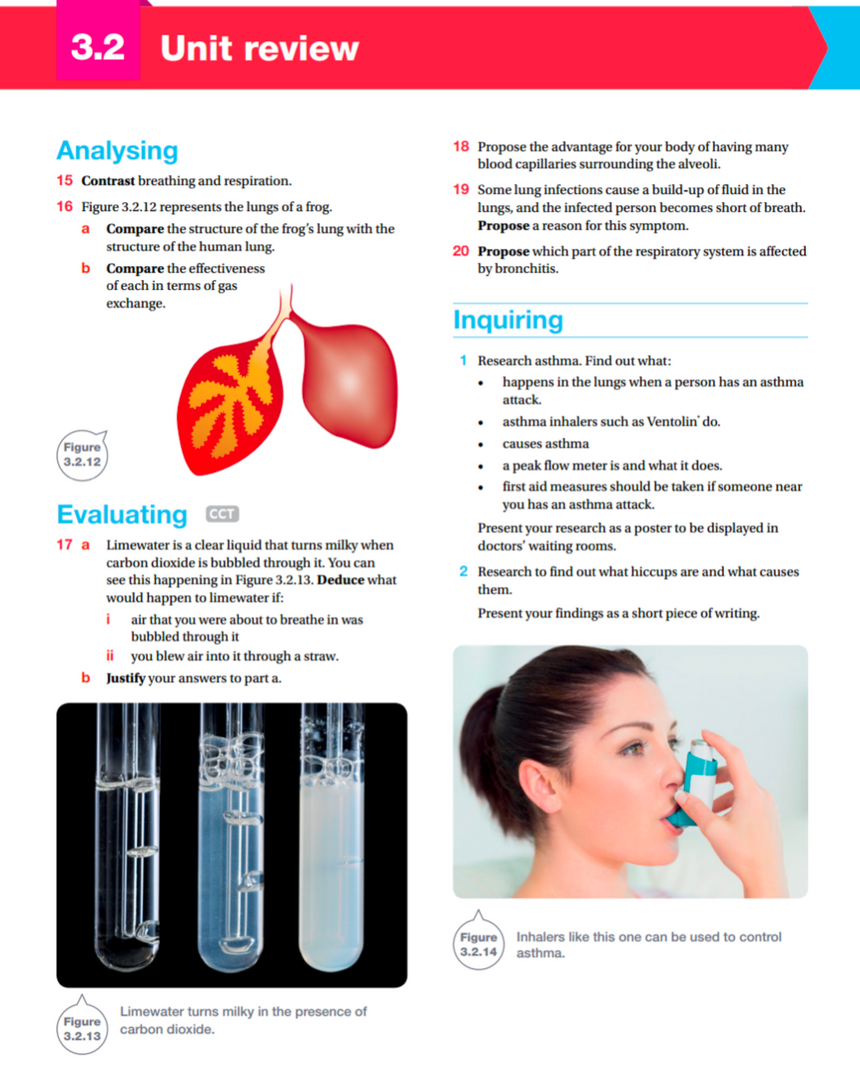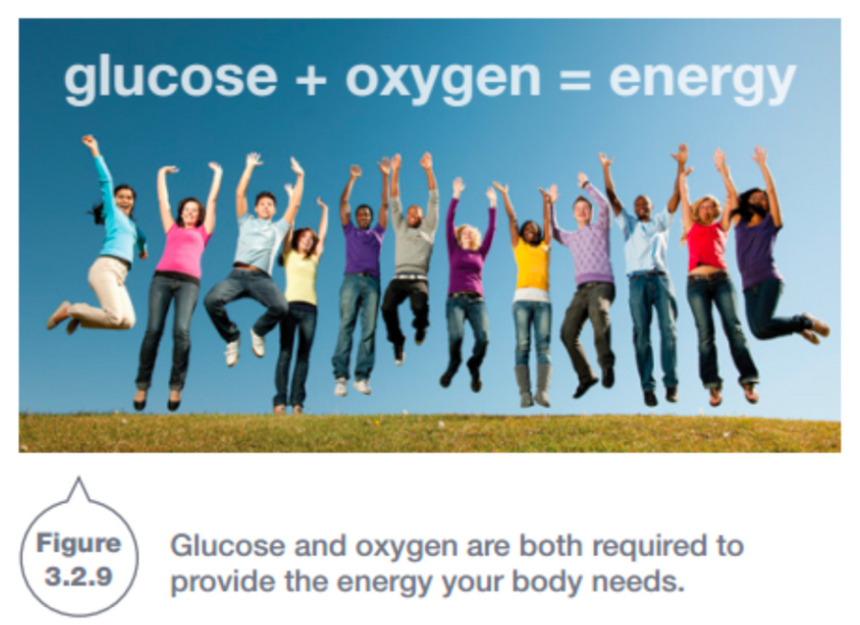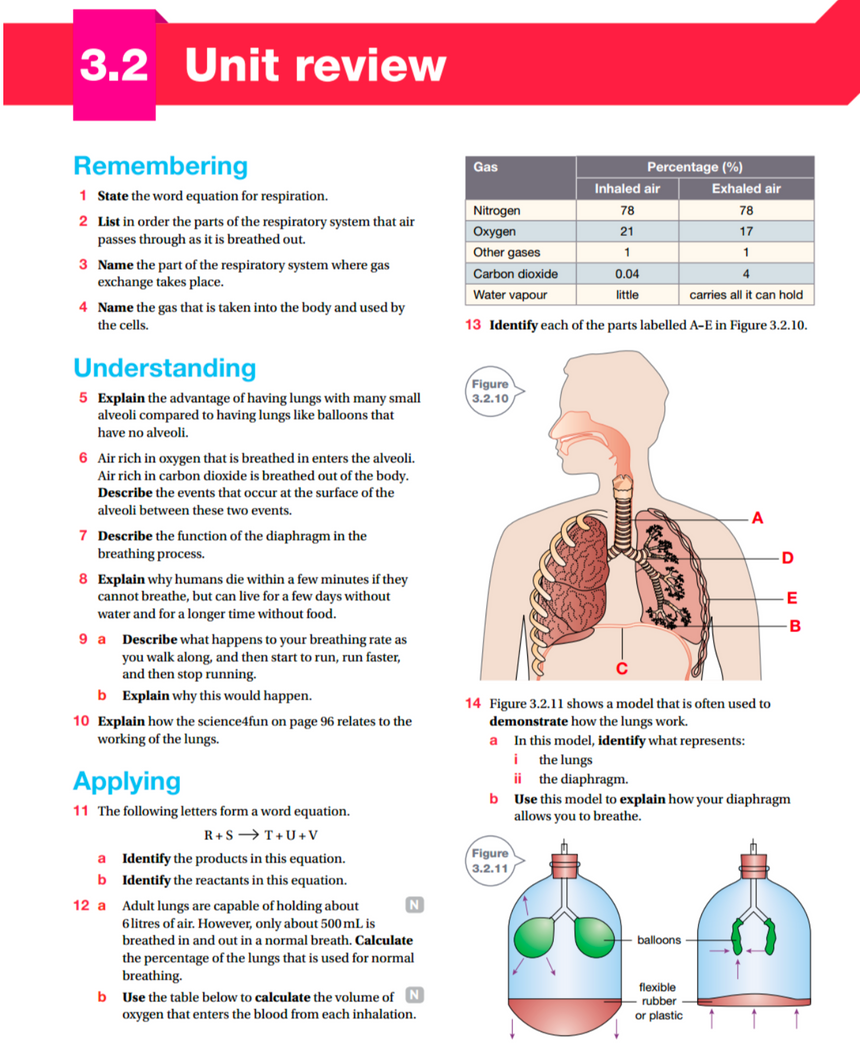
You need food and oxygen to make energy available in your cells. Your digestive system processes food to provide glucose, the main source of the chemical energy your cells need. Your respiratory system supplies the oxygen needed by your cells and gets rid of the carbon dioxide produced by them as waste. The lungs and trachea, parts of the respiratory system, are shown here in red.

Respiration
Respiration refers to the series of chemical changes that take place in cells to release energy.
Where the air goes
When you breathe in, some air may come in through your mouth but most of it comes in through your nose. Within the nasal cavity, the air is warmed and moistened. Large dust particles are filtered out as the air passes through the hairs inside your nostrils. Glands in the skin lining the nose produce sticky mucus. The mucus helps tiny hairs called cilia lining the nose to trap fine particles.

The mucus with the trapped particles then moves to the back of the nose and into the pharynx. It is then swallowed.
You swallow about 600 mL of mucus every day without being aware of it.
The warm, moist air then passes down the trachea (windpipe). The thin walls of the trachea are reinforced with rings of a firm elastic material called cartilage that keep your trachea from collapsing as you breathe in. You can feel these rings as ridges on the front of your throat. They are shown in Figure 3.2.3. The trachea divides into two bronchi (singular: bronchus), which divide and divide into ever smaller tubes (bronchioles), eventually ending in a cluster of sacs called alveoli (singular: alveolus) in the lungs.
Alveoli are microscopic in size and about 600 million of them make up your lungs. The alveoli provide a very large surface area, allowing gas to be easily exchanged between the lungs and bloodstream. Figure 3.2.4 shows the alveoli in a section of a lung. Figure 3.2.5 on page 96 shows a magnified view oflung tissue.



Gas exchange
The walls of the alveoli are only one cell thick and they are surrounded by tiny blood vessels called capillaries. Oxygen dissolves in the moist surface of the alveoli and moves by a process called diffusion across the short distance from the space inside an alveolus to the blood. Figure 3.2.6 illustrates this process.

Once in the blood, the oxygen enters the red blood cells, and the flow of blood carries the oxygen to the cells where it is needed. The blood flowing from the lungs is therefore rich in oxygen and is bright red.
The cells use the oxygen to release energy from food. As they do this, carbon dioxide is produced. Carbon dioxide is a waste product that would harm your body if you did not get rid of it. Carbon dioxide moves from your cells into the blood and from your blood into the alveoli, where it mixes with the remaining air. It then leaves the body with your next outward breath.
Once in the blood, the oxygen enters the red blood cells, and the flow of blood carries the oxygen to the cells where it is needed. The blood flowing from the lungs is therefore rich in oxygen and is bright red.
The cells use the oxygen to release energy from food. As they do this, carbon dioxide is produced. Carbon dioxide is a waste product that would harm your body if you did not get rid of it. Carbon dioxide moves from your cells into the blood and from your blood into the alveoli, where it mixes with the remaining air. It then leaves the body with your next outward breath.


The air in the alveoli is constantly replaced when you breathe. Breathing is involuntary. Although you can force yourself to stop breathing for a while, breathing-is something you do without thinking, all day, every day.
As you breathe in, the muscles between your ribs contract. This pulls the rib cage up and out. At the same time the diaphragm-a sheet of muscle that separates the chest from the abdomen-contracts and flattens. This situation is shown in Figure 3.2.8.

These changes increase the volume of the space inside your chest. Your lungs expand, which causes the air pressure in them to decrease. Air is sucked in through the nose (and mouth) to fill up the extra space. This makes the air pressure inside your lungs equal to the air pressure outside the body.
When you exhale, the opposite happens. All the muscles relax.The ribs therefore move down and in, and the diaphragm arches upwards. The volume inside the chest returns to its normal size and the air pressure increases. This forces air out of the lungs, to exit through the nose and mouth.
Respiration begins once the oxygen and glucose are together in the cells, where the two chemicals react together. Carbon dioxide and water are produced in the reaction, and energy is released. It is this energy your body uses for all its activities (Figure 3.2.9).
The chemical reaction for respiration can be represented by a word equation.

The more energy your body requires, the faster this reaction has to take place, and therefore more oxygen and glucose are required.

Energy and oxygen
The amount of energy you consume in your food needs to balance the amount of energy you use. When you consume more energy than your body requires, the excess nutrients are converted to fat and stored in a layer under your skin and around your internal organs. Your mass increases, and over a long period of consuming too much you could become overweight or obese. Becoming overweight may cause health problems because your joints have to support too much mass, your heart has to work a lot harder, and your blood vessels may become blocked by a build-up of a fatty substance called cholesterol.
If you take in less energy in your food than your body requires, you use up any fat stores (stores of energy) and lose mass. This is not a problem if you have extra mass to lose, but if you do not have stores of fat, then your body starts to get energy by using muscle tissue, including heart muscle. The muscles of your arms and legs become weak and your heart is weakened.
To get more oxygen into your cells you have to breathe more quickly or more deeply. You then have to move the oxygen more quickly around the body. To achieve this, you need to build up your heart muscles and the muscles associated with breathing. Just as your arms and leg muscles get stronger with exercise, the muscles of your heart get stronger when it is made to work harder.
Strong heart muscles mean that the heart is able to pump more blood out of the heart with each beat.



